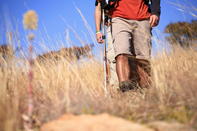The First to Appear
Things were pretty peaceful on the Highveld of South Africa for most of the 1700s. Then, in the 1800s, two new groups of settlers arrived and turned everything upside down. The first to appear on the scene was an African tribe called the Matabele (later Ndebele).

They were once part of the Zulu nation under the powerful King Shaka. However, in 1824, the Matabele chief Mzilikazi quarrelled with Shaka and fled over the Drakensberg with thousands of followers. The Matabele were fearless and ferocious warriors who proceeded to wreak havoc across the formerly placid interior.
Although based near Pretoria, Matabele bands terrorised the countryside and caused widespread disruptions. This turbulent period is known as the Difaqane (which is related to but not the same as the Mfecane, which occurred in the coastal regions).
The Second Group
The second group of intruders where of a different hue, quite literally. They were the white settlers who had been dribbling up from the Cape since the turn of the century. Some came in search of adventure, some were missionaries, some were hunters looking for game.
At first, these strange pale people were tolerated by the local tribes, who traded with them and even accompanied them on their hunting trips into the wild hinterland. In 1834, however, the Great Trek began and the trickle became a steady stream of whiteys.
The trek was a result of Boer dissatisfaction with British rule (and the abolition of slavery) at the Cape, and the iconoclastic boer farmers decided to leave the colony to establish a new country where they could rule supreme.
Several streams of Trekkers subsequently spread out into the interior in search of their Eden. One of these parties, under the leadership of Andries Hendrik Potgieter arrived in the Vredefort area in 1836 and began establishing large farms, much to the consternation of the local people.
There was a trade-off, however, because the boer guns proved to be a useful deterrent against the Matabele. Nevertheless, the situation was fraught with tension.
The Attack
Things came to a head later that year when several boer families were murdered by a Matabele raiding party, and three children were kidnapped.
The attack took place on the north bank of the Vaal River, very close to the present-day town of Parys.
Andries Hendrik Potgieter was furious and sent out a number of retaliatory parties to punish the Matabele for the massacre. As a result of this and other attacks, Mzilikazi eventually withdrew from the region and decamped north of the Limpopo to establish a new capital near Bulawayo.
It’s Potch!
In 1837, while returning from a victorious battle against the Matabele, Potgieter first noticed the fertile banks of the Mooi (Pretty) River and decided that it would be a good place for a town. In 1838, streets were duly laid out and several houses were built.
Unfortunately, the wet season of 1840 demonstrated that the settlement had been established on a soggy piece of marshland, and a new town was quickly established at a better site about 11km downstream from the Oudedorp (old town). After going through a number of names, this village was eventually called Potchefstroom (thought to be a conflation of ‘stream of the Chief Potgieter’).
Potch (as it is familiarly known) was the first boer municipality north of the Vaal River. After the signing of the Sand River Convention in 1852, it also became the first capital of the Zuid Afrikaanse Republiek (South African Republic or the old Transvaal). As such, it was a very important place. The first president of the ZAR took his oath of office in Potch.
The ZAR’s constitution was drawn up in Potch. The Vierkleur (official flag of the ZAR) got its first airing in Potch. The Transvaal’s first newspaper was printed in Potch. And the first teacher north of the Vaal was based in Potch. Way to go, Potch! Unfortunately, the capital of the ZAR moved to Pretoria in 1860, leaving Potch out in the cold.
The town went on to develop into a major agricultural, mining and educational centre.
By David Fleminger